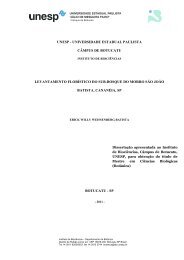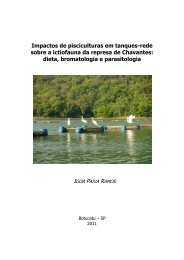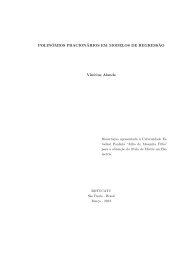Visualizar Tese - Instituto de Biociências - Unesp
Visualizar Tese - Instituto de Biociências - Unesp
Visualizar Tese - Instituto de Biociências - Unesp
You also want an ePaper? Increase the reach of your titles
YUMPU automatically turns print PDFs into web optimized ePapers that Google loves.
Andreo Fernando AguiarFig. 1. Sketch of the resistance training apparatus. Adapted from Tamaki et al. (57)Anatomical data. Throughout the experiment the body weight and food intake ofanimals were monitored daily. At the end of the respective training periods the animalswere anesthetized with pentobarbital sodium (40 mg/kg IP) and sacrificed by<strong>de</strong>capitation. The plantaris muscle of right and left legs was removed and its weight wasnormalized to body weight (muscle weight/body weight ratio). The middle portion ofright muscle was collected and frozen in isopentane cooled in liquid nitrogen (–156 °C)for morphometrical, histochemical and biochemical analysis. The left muscle wasdirectly frozen in liquid nitrogen at –156ºC for molecular analysis. Samples were kept at–80ºC until use.Morphometrical analysis. Plantaris histological sections (10µm thick) wereobtained in a cryostat (JUNG CM1800, Leica, Germany) at –24°C and stained withhematoxylin and eosin (HE). The stained sections were used for photographicdocumentation of three random histological fields (20µm lens) of each animal. Theimages were obtained in a microscopy connected to a computer. Muscle hypertrophywas <strong>de</strong>termined by measurement of cross-sectional area (CSA) of the ~ 400 musclefibers of each animal (Fig. 4A, B, C and D). This corresponds to approximately 80% ofamount plantaris muscle fibers. Cross-sectional area (CSA) measure was performedusing an image analysis system (software Leika QWin Plus, Germany).Histochemical analysis. Muscle samples previously stored in a freezer at –80°Cwere thawed to –20°C and sectioned serially (10µm thick) for histochemical analysis.To <strong>de</strong>termine the muscle fiber-type percentages, myofibrillar a<strong>de</strong>nosine triphosphatase48
















